How often do you feel disappointed with your underwater pictures?
Maybe wondered: am I or the camera to blame?
You are not alone!
After 40 years on the job, I still feel disappointed each time I first see
a
roll of newly
developed film...
But I trust my own eyes more than I trust the ability of the film to render
my visual impressions correctly.
And I have found tricks to MAKE my images show what I have REALLY seen.
So
– what does the underwater world look like
– really??
|
Perches
in lake Largen by Norrtälje – is their rightful appearance
|
| this...
|
...
or this? |
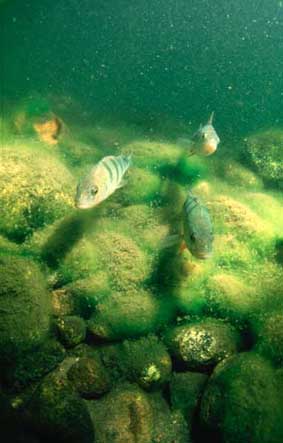 |
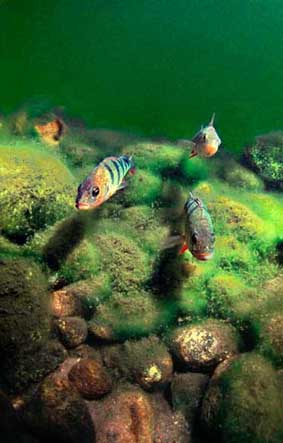 |
|
The "snow
blizzard" of backscatter in the background is inevitable. Use of
a flashgun is necessary. The greenish haze of the foreground in just
as inevitable. The water itself is green and hazy. But the "raw
scan" to the left gives a poor rendition of what I remember from
the dive. In the computer I have restored the image to conform with my
visual impression when the picture was taken.
|
|
Red
Sea coral reefs outside Hurghada – is
their rightful appearance
|
| this...
|
...
or this? |
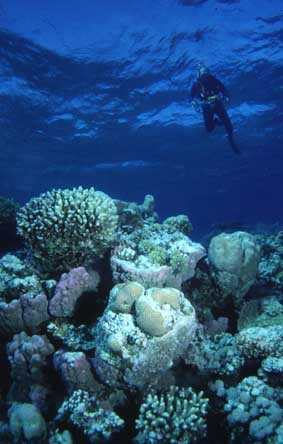 |
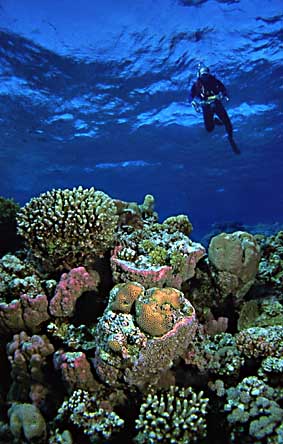 |
|
Although I
used a flashgun, the corals of the foreground were rendered pale blue
on the original slide. The flash had no chance to dominate over the strong
blue natural light. How many of your pictures from dive trips to tropical
waters are similar to the one above left? How do you remember the colours
of a coral reeftop?
|
|
Some
waters are awful for a photographer. Baby trout in Skräbe river
– is their rightful appearance
|
| this...
|
...
or this? |
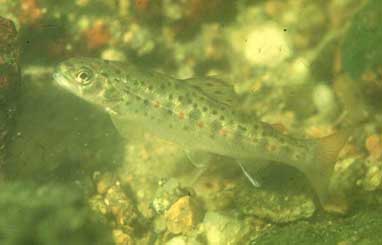 |
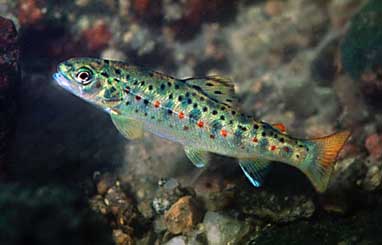 |
|
At such short
distance only strobelight exposed the film. But the light from the flashgun
was filtered through half a meter of hazy green-yellowish river water.
With results accordingly. My original slides (left) were considered useless
for many years. Until I got a computer with scanner and image editing
software.
|
Is it "cheating"
to edit images this way?
In my
opinion – a resounding NO!
I have added nothing
to the images that wasn't there from the beginning. I have neither moved
nor taken away anything – except dust on the slide and the white dots
from the backscattered flashlight. So what have I done?
First, I have carefully
balanced the colours in the image relative to each other. Old photographers
call it "to correct colour casts". In the digital world (video
and still images alike) the expression is "white balance". Then
I have amplified already existing colours ("increased the colour saturation")
until the appearance of the image is in accordance with my memory from the
moment I exposed the film.
Colour film as
well as digital cameras have their serious faults. But both are made for
taking pictures in air!! The computer editing software helps me to compensate
for those faults. I restore the images to the appearance they should have
had from the beginning...
The job may seem
tedious. And slow. Usually I spend one full hour per image before the result
is satisfactory.
I
can help you to reach similar results
with your images!
Option
1: you send me your images (colour slides or negatives. NOT prints!).
I scan them, edit them and return the results on CD and/or printed on
paper. This is not a cheap method. One full hour per image... what do
you charge per hour?
Option
2: You have access to scanner, computer and software. I will be
your teacher on a seminar or a workshop. You and your friends learn
the tricks. And share the costs...
Of course,
the same principles apply also to images from digital cameras.
|
Some
thoughts from an aging photographer:
In the old days
of black&white-only photography, no professional photographer worth
his salt would ever dream of sending a b&w negative to an editor or
a picture agency. No. He went to his darkroom, put the negative into the
enlarger and produced the best photographic print he knew how to do. The
right grade paper, the right developer, a little shading here, a little
extra burning there, maybe a mask for the highlights or shadows... Making
a good print from a negative might very well take an hour or more, and require
several failed attempts.
With the advent of colour film (reversal and negative), very few photographers
had the skills or capacity to master the necessary darkroom techniques.
Instead, they were obliged to send their precious original colour slides
as they were for lithography or scanning, and to editors and agencies all
over.
Photographers lost control over the appearance of their images in magazines,
papers and all printed matter. To regain it, they tried to make the "camera
original" into a kind of Holy Grail that the b&w negative never
was!
Today, with scanners
and editing software, photographers have the chance to really regain
control over their images. But the lithographic industry has invested heavily
in drum scanners worth millions – and they take countermeasures. "Send
us your camera originals, and we will scan them. Printing from anything
the photographer himself has scanned is impossible" they claim. They
are bluffing. Call the bluff!
I belong to the
few photographers who have bothered to learn the colour darkroom techniques.
For nearly 40 years I have developed colour reversal film, made colour duplicates
of all sizes and produced large colour prints. To me, a colour slide is
nothing more than a piece of raw material to make an interesting and enjoyable
image from. The resulting image need not even have a true similarity with
the original it was made from – and I call the shots.
With the possibilities
offered by the digital techniques, all photographers can learn to do that.
Take the chance!
|